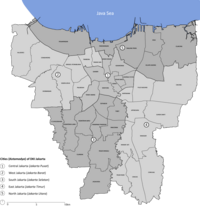
Banten is the westernmost province on the island of Java, Indonesia. Its capital city is Serang and its largest city is Tangerang. The province borders West Java and the Special Capital Region of Jakarta on the east, the Java Sea on the north, the Indian Ocean on the south, and the Sunda Strait on the west and shares a maritime border with Lampung to the west. The province covers an area of 9,352.77 km2 (3,611.12 sq mi). It had a population of over 11.9 million in the 2020 census, up from about 10.6 million in 2010. The estimated mid-2023 population was 12.308 million. Formerly part of the province of West Java, Banten was split off to become a province on 17 October 2000.

North Jakarta, abbreviated as Jakut, is one of the five administrative cities which form Special Capital Region of Jakarta, Indonesia. North Jakarta is not self-governed and does not have a city council, hence it is not classified as a proper municipality. It contains the entire coastal area within the Jakarta Special Capital Region. North Jakarta, along with South Jakarta is the only two cities in Jakarta to border Banten and West Java. It is also the only city of Jakarta with a coastline and thus not landlocked. North Jakarta, an area at the estuary of Ciliwung river was the main port for the kingdom of Tarumanegara, which later grew to become Jakarta. Many historic sites and artefacts of Jakarta can be found in North Jakarta. Both ports of Tanjung Priok and historic Sunda Kelapa are located in the city. The city, which covers an area of 139.99 km2, had 1,645,659 inhabitants at the 2010 census and 1,778,981 at the 2020 census; the official estimate as at mid 2023 was 1,801,963. It has its administrative centre in Tanjung Priok.

Penjaringan is a district of North Jakarta Administrative City, Indonesia. It is the westernmost district of North Jakarta. Muara Angke Port and the mouth of Sunda Kelapa Port are located within Penjaringan. Penjaringan contains the remnants of the original mangrove forest of Jakarta, some of which are protected by the Muara Angke Wildlife Sanctuary.
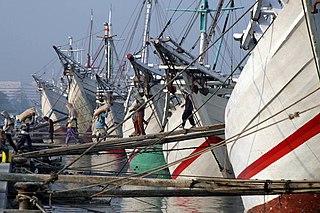
Sunda Kelapa is the old port of Jakarta, located on the estuary of the Ciliwung River. "Sunda Kalapa" is the original name, and it was the main port of the Sunda Kingdom. The port is situated in Penjaringan District, of North Jakarta, Indonesia. Today the old port only accommodates pinisi, a traditional two-masted wooden sailing ship providing inter-island freight service in the archipelago. Although it is now only a minor port, Jakarta has its origins in Sunda Kelapa and it played a significant role in the city's development. The port is currently operated by the state-owned Indonesia Port Corporations.
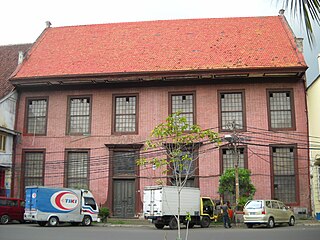
Toko Merah is a Dutch colonial landmark in Jakarta Old Town, Indonesia. Built in 1730, it is one of the oldest buildings in Jakarta. The building is located on the west side of the main canal Kali Besar. The building's red color contributes to its current name.
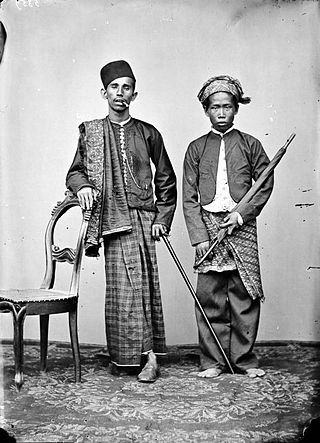
Kapitan Arab or Kapten Arab or Head of The Arabs is a position in the colonial Dutch East Indies appointed with the task of leading the ethnic Arab-Indonesians, who usually lived in concentrated clearly defined-living areas. The role was to provide liaison between his community and the government, to provide statistical information to The Dutch East Indies government on issues related to Arabs, to disseminate government regulations and decrees, and to ensure the maintenance of law and order.
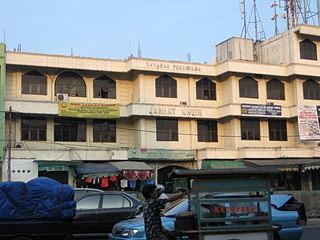
Jamiat Kheir is one of a few early private institutions in Indonesia that is engaged in education, and is instrumental in the history of Indonesian struggle against Dutch colonialism, preceding Sarekat Islam and Budi Utomo. It is headquartered in Tanah Abang, Central Jakarta.

Rabithah Alawiyah is an Indonesian Islamic organization engaged in social movements. In general, the organization is an exclusive association of Hadhrami people of Ba 'Alawi sada families. The organization was established on December 27, 1928, CE or 1346 AH, not long after the Soempah Pemoeda October 28, 1928. The organization has a sub-organization called al-Maktab al-Daimi given task to collect, verify and maintain genealogies of Ba 'Alawi sada and print pedigree passes to prove the ancestry of individuals around the world.

Ali bin Abdurrahman al-Habshi, better known as Habib Ali of Kwitang or Habib Ali Kwitang, was one of the leading Islamic clerics and preachers in Jakarta in the 20th century. He was also the founder and chairman of the Majelis Taklim Kwitang and Islamic Center Indonesia, which are the forerunners of other religious organizations in Jakarta.
Sa'id bin Salim Na'um Basalamah or better known as Said Naum was the first Kapitan Arab in Batavia and a Muslim philanthropist in Dutch East Indies in the 19th century. He is known for his charities and endowment of large lands to be used as school and cemetery currently located in Tanah Abang.

Alwi bin Thahir al-Haddad was an Islamic scholar known as the Mufti of Johor in twentieth century and also the co-founder of Jamiat Kheir and Al-Rabithah al-Alawiyyah foundations in Batavia during colonial Dutch East Indies.

Usman bin Yahya, Utsman ibn Yahya or Othman bin Yahya was an Islamic scholar who served as Grand Mufti of Batavia in 19th century of Dutch East Indies.

Masjid Jami Kampung Baru Inpak, also known as Masjid Kampung Baru or Bandengan Mosque, is one of the oldest mosques in Jakarta, Indonesia. It is located at Jalan Bandengan Selatan, Pekojan, Tambora, Jakarta, close to Masjid Al-Anshor. It is one of the mosques that was built by Muslim merchants from India who used to travel to and live in Batavia. The mosque has been designated as cultural heritage by the provincial government of DKI Jakarta.

Drs. Kyai Hajji Habib Ali Alwi bin Thohir Al Husainy is an Indonesian politician, da'i, Islamic scholar and founder of the Pondok Pesantren Modern Al-Husainy, Serpong, South Tangerang, Banten. At the election of regional head and deputy regional head of Tangerang Regency in 2008, Alwi was nominated by the Democrat Party and the National Awakening Party as a candidate for vice regent along with Usamah Hisyam as a candidate for regent, but this pair was defeated by incumbent candidate Ismet Iskandar with Rano Karno as his deputy. Currently, Alwi serves as a senator representing the province of Banten in the Regional Representative Council.

Husein Aidid was an Indonesian songwriter, singer and entrepreneur. Aidid was the founder and leader of the Orkes Gambus al-Usysyaaq which later became transformed into the Orkes Melayu Kenangan in 1950. Together with his new Malay Orchestra, on October 26, 1950, Aidid began its first broadcast on Radio Republik Indonesia and was broadcast nationally. At that time, RRI was the most popular entertainment facilities of society.
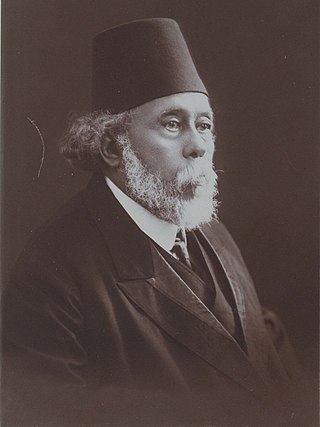
Sayyid Abdullah bin Alwi Alatas was a Dutch East Indies merchant, landlord, and philanthropist of Arab descent from the Ba 'Alawi sada clan. Alatas is also the owner of the Cikini House after it was bought from Raden Saleh. He also inherited another eccentric house, such as a house built by a Frenchman in an Islamic style.
Alwi Shahab was an Indonesian journalist for more than 40 years who mainly focused on Jakarta's socio-cultural problems. His career began in 1960 as a journalist at the Arabian Press Board news agency in Jakarta.
Rumah Panggung is one type of traditional Betawi house whose floor is raised from the ground using wooden poles. This house is different from a Rumah Darat that sticks to the ground. Betawi houses on stilts are built in coastal areas with the aim of dealing with floods or tides. Meanwhile, stilt houses located on the banks of rivers such as in Bekasi are not only built to avoid flooding, but also for safety from wild animals.


